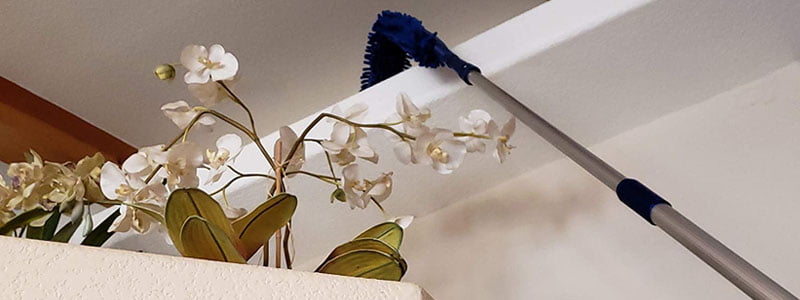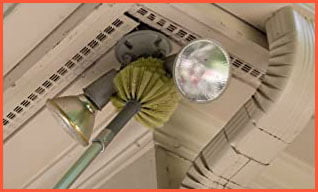

There are very few people in this world who can claim that they’re not afraid of spiders. If you’re amongst those few superheroes, kudos to you!
However, for the rest of us, spiders and spiderwebs remain nightmarish! Yet, that doesn’t exempt us from cleaning.
If you were ever assigned with cleaning cobwebs from ceilings, you know how difficult it may get. To make your life easier, we’ll show you how to clean spider webs from high ceilings
We’ll also see what tools you can use to make the task easier and also what measures you can take.
By just keeping a few things in mind and following the easy steps, you’ll be able to banish cobwebs from even the hardest to reach places.
So, without further ado, let’s see how it’s done.
What You’ll Need
Before delving into the steps, let’s take a glance at the list of things you’ll need to get this work done. Check the list beforehand and tick off everything you already have.
- Plastic sheets
- Step ladder
- Duster with an extendable handle
- Gloves
- Plastic bag
- Spray bottle
- Vinegar
- Water
Depending on the height of your ceiling, you’ll need a step ladder or a duster with an extendable handle, or both.
Although we’ll go into the details a bit later, it’s a good idea to invest in both if your ceiling is higher than 20 ft.
That’s because a tool or step ladder will give you some added height and as a result, more stability. This is pretty crucial when it comes to cleaning the cobwebs with precision.
4 Steps on How to Clean Spider Webs from High Ceilings?
Cleaning cobwebs are pretty hard, to begin with. They’re icky and unless it’s an empty web, there’s always the impending fear of having to face an angry spider.
But add some height to that, and the task becomes twice as difficult. You lose grip and the precision to completely get rid of the cobweb.
Although this is a bit of a challenge, it’s not all that hard once you have all the right equipment.
Let’s see how it’s done.
Step 1: Line the floors with plastic sheets
Before we get into the details of cleaning, we must first protect the floor. Prepping the surface of the room you’re about to clean is absolutely mandatory, since the cobwebs won’t end up on the couch.
Unless you want some baby spiders to crawl on your face in the middle of the night, protect your bedding and floors beforehand. This is super important, especially if you have carpeted floors.
To do this, simply buy some big plastic sheets and line your furniture and floors with them.
On another note, this tip works wonders even when you’re cleaning a greasy ceiling fan. No matter what the task is, a little bit of protection goes a long way!
Step 2: Extend the pole and clean the cobwebs


Now comes the star of our performance- an extendable duster. When it comes to high ceilings, just getting on a step ladder may not always cut the chase for you.
Especially if your ceiling is more than 20 ft high, you may need to use both a stepladder and an extendable duster to get the job done.
Now depending on your home style, we’ll leave this choice to you. Simply extend the duster until you can easily reach the spot that’s covered in cobwebs.
If you find that you’re not really having precision or control with such a long handle, then shorten it and climb up a stepladder.
Try different combinations until you feel comfortable and have a good grip. In case you opt for a non-extendable duster, you could always check out some amazing cobweb dusters.
After all, you’re the boss.
Step 3: Clean the duster
Now that you’ve removed the cobwebs from the ceiling, it’s time to clean the brush.
If your ceiling isn’t too high, skip the duster. A handheld vacuum can work wonders instead.
This saves you from a lot of cleaning and is totally mess-free! However, when you reach great heights, there comes great responsibility.
So, with a high ceiling, the cleaning gets a little troublesome. Back to the topic, to clean cobwebs from the duster, wear some gloves. Gloves will prevent you from getting any bites or rashes from hidden spiders.
Also, it’ll give you that extra bit of courage which is needed to handle spiders.
Then, remove them by hand and discard them in a plastic bag. If you see any live eggs in them, then you may want to follow up on the next step.
Step 4: Spray vinegar
Last but not least, what to do if you have a spider infestation at home? Although if serious, we suggest you call pest control and not take matters into your hand.
That’s because spider infestations may sometimes be dangerous and you’ll have no way of knowing unless you’re bitten by a poisonous spider. So, don’t take the risk.
But if it’s just a few spiders here and there, then a homemade solution of vinegar and water may just do the trick.
Mix one cup of vinegar with two cups of water and mix it well. After that’s done, pour it into a spray bottle and spray it on any areas where spiders may choose to make their home.
This repels spiders and can also potentially kill spider eggs.
Bottom Line
So that’s a wrap on the topic. We hope you learned something new and remember, always call pest control if you notice a spider infestation.
If you liked our tips on how to clean spider webs from high ceilings, don’t forget to tell us in the comments below.
We’d love to hear from you. Bye until next time!